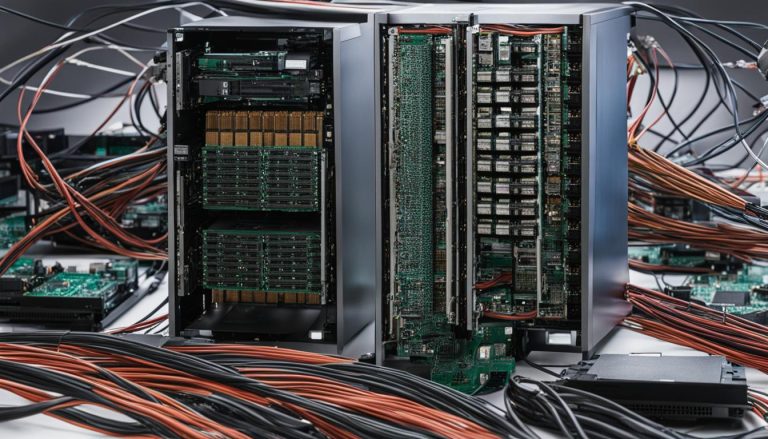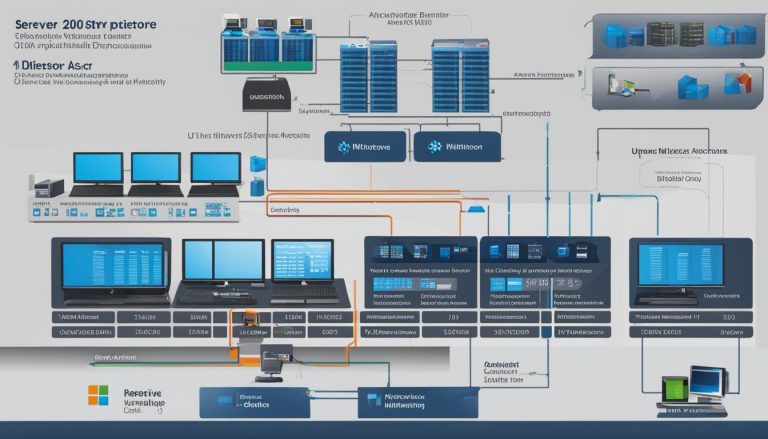Welcome to my essential guide on understanding Windows Server 2003! In this article, we will explore the definition and key features of Windows Server 2003, an operating system that revolutionized IT infrastructure. Whether you’re a system administrator or an IT enthusiast, this guide will provide valuable insights into the world of Windows Server 2003.
Windows Server 2003 is a powerful and feature-rich operating system that introduced a range of new functionalities and administrative implications. Its significance in the IT landscape cannot be underestimated, as it provided administrators with enhanced control and flexibility in managing server environments.
Key Takeaways:
- Windows Server 2003 is a complex and feature-rich operating system.
- It introduced several key features that revolutionized IT infrastructure.
- Support for Windows Server 2003 ended in 2015, necessitating an upgrade to ensure security and functionality.
- Understanding the architecture, installation process, and key features of Windows Server 2003 is essential for effective server management.
- Active Directory, user management, security measures, and more are vital aspects of Windows Server 2003 administration.
About Windows Server 2003
Windows Server 2003, released in 2003, quickly became a popular choice for managing servers due to its advanced features and capabilities. However, it is important to note that support for Windows Server 2003 ended in 2015, marking its end of life. This means that the operating system no longer receives updates or security patches from Microsoft.
Without ongoing support, Windows Server 2003 becomes more vulnerable to security threats and compatibility issues. It is crucial for organizations still using this outdated version to consider upgrading to a newer, supported version of Windows Server.
Upgrading to a newer version of Windows Server provides several benefits. First and foremost, it ensures that your server infrastructure remains secure and protected against the latest threats. It also enables you to take advantage of the latest features and improvements in server management, performance, and reliability. Additionally, upgrading allows you to access ongoing support from Microsoft, which includes technical assistance and access to updates and patches to keep your systems up to date.
Table: Reasons to upgrade from Windows Server 2003
| Reasons | Benefits |
|---|---|
| Enhanced Security | Protect your infrastructure against current vulnerabilities and cyber threats. |
| Improved Performance | Take advantage of the latest advancements in server technology for better performance and reliability. |
| Ongoing Support | Access technical assistance, updates, and patches from Microsoft to keep your systems up to date. |
| New Features | Leverage the latest features and improvements in server management and administration. |
By upgrading from Windows Server 2003, organizations can ensure the security, reliability, and performance of their server infrastructure while gaining access to ongoing support and the latest technological advancements.
Key Features of Windows Server 2003
Windows Server 2003 introduced a range of key features that significantly enhanced the capabilities of the IT infrastructure. These features not only improved stability and reliability but also provided enhanced security measures, making it a valuable choice for server management.
Improved Stability and Reliability
One of the standout features of Windows Server 2003 is its enhanced stability and reliability. The operating system was designed to handle large workloads and provide high availability for critical applications. This improved performance ensured smooth operations and minimal downtime, making it a reliable choice for businesses.
Enhanced Security Measures
Security is a top priority for any server environment, and Windows Server 2003 addressed this by introducing enhanced security measures. It provided comprehensive security controls, including improved access control and auditing capabilities. Additionally, the operating system incorporated features like Windows Firewall, which helped protect against unauthorized access and potential threats.
Active Directory for User Authentication
Windows Server 2003 introduced Active Directory, a powerful directory service that revolutionized user authentication and management. Active Directory simplified the process of managing user accounts, groups, and organizational units, providing a centralized mechanism for controlling access to network resources. This feature greatly enhanced the efficiency and security of user administration.
Other notable features of Windows Server 2003 include support for XML and Active Server Pages (ASP), allowing for dynamic web content creation, as well as the ability to define server roles, enabling administrators to allocate specific functions to different servers in a network.
| Key Features | Description |
|---|---|
| Improved Stability and Reliability | Enhanced performance and minimized downtime for critical applications. |
| Enhanced Security Measures | Comprehensive security controls and protection against unauthorized access. |
| Active Directory | Centralized user authentication and management for improved efficiency and security. |
| Support for XML and ASP | Dynamic web content creation capabilities. |
| Server Roles | Allocation of specific functions to different servers in a network. |
Windows Server 2003 introduced a range of key features that improved stability, enhanced security, and provided greater control for administrators. These features, along with its support for XML, Active Server Pages, and the ability to define server roles, made it a game-changing operating system for IT infrastructure.
Understanding the key features of Windows Server 2003 is crucial for effective server management and ensuring the security and functionality of your server environment. From improved stability and reliability to enhanced security measures and user authentication with Active Directory, Windows Server 2003 offered a comprehensive solution for businesses.
Understanding Windows Server 2003 Architecture
To effectively install and manage Windows Server 2003, it is important to understand its architecture. This knowledge will not only help you navigate the intricacies of the operating system but also ensure that your server meets the necessary system requirements. Let’s delve into the structural layers, subsystems, managers, boot process, registry structure, and application dependencies that form the foundation of Windows Server 2003.
Operating System Layers
Windows Server 2003 has multiple layers that interact to provide a seamless user experience. These layers include the Hardware Abstraction Layer (HAL), kernel-mode layer, executive services layer, and user-mode layer. The HAL interacts directly with the server’s hardware, while the kernel-mode layer handles critical system components. The executive services layer manages system resources, and the user-mode layer supports user applications and interfaces.
Subsystem and Managers
Windows Server 2003 contains several subsystems and managers that enable various functionalities. The Windows subsystem handles graphical user interfaces, command-line interfaces, and virtual DOS machines. The POSIX subsystem provides compatibility with the POSIX standard for Unix-like operating systems. The Object Manager manages system objects such as files, processes, and threads. The Security Reference Monitor enforces security policies, and the Power Manager controls the server’s power-saving features.
Boot Process and Registry Structure
When starting Windows Server 2003, the boot process initializes the hardware, loads system files, and starts the operating system. The registry, a hierarchical database, stores configuration settings and preferences for the operating system, applications, and users. It is divided into several hives, including HKEY_LOCAL_MACHINE, HKEY_USERS, and HKEY_CURRENT_CONFIG, each serving a specific purpose.
By understanding these architectural elements, you can navigate and optimize your Windows Server 2003 environment, ensuring smooth operations and efficient resource management. Now that we have explored the architecture, let’s move on to the installation and configuration of Windows Server 2003.
Installation and Configuration of Windows Server 2003
In this section, we will explore the installation and configuration process of Windows Server 2003. It is essential to follow these steps carefully to ensure a successful deployment of the operating system. Whether you are performing a fresh installation or upgrading from a previous version, these guidelines will help you navigate the installation process smoothly.
There are three main methods of installing Windows Server 2003: manual installation, automated installations, and remote installations. Manual installation involves booting from the installation media and following the on-screen prompts to complete the setup. This method gives you full control over the installation process and allows you to customize each step according to your specific requirements.
Automated installations, on the other hand, enable you to streamline the installation process by creating answer files that provide preconfigured settings. These answer files can be created using the Setup Manager tool, which allows you to specify options such as regional settings, network configuration, and server roles. By using automated installations, you can save time and ensure consistency across multiple installations.
Remote installations are useful when you need to install Windows Server 2003 on multiple machines without physically interacting with each one. This method requires a Remote Installation Services (RIS) server, which stores the operating system image and deploys it to client computers over the network. With remote installations, you can easily deploy Windows Server 2003 to a large number of machines efficiently.
Table: Comparison of Windows Server 2003 Installation Methods
| Installation Method | Key Features |
|---|---|
| Manual Installation | – Full control over installation process – Customization options available – Suitable for individual installations |
| Automated Installations | – Streamlined installation process – Consistent settings across installations – Ideal for deploying multiple servers |
| Remote Installations | – Deployment of Windows Server 2003 to multiple machines – Time-saving and efficient – Requires Remote Installation Services (RIS) server |
By understanding and utilizing these installation methods, you can effectively deploy Windows Server 2003 to meet your specific needs. Whether you prefer a manual installation for full control, automated installations for efficiency, or remote installations for large-scale deployments, Windows Server 2003 offers flexibility and convenience.
Now that we have explored the installation and configuration process, we can move on to the next section, which focuses on Active Directory and User Management in Windows Server 2003.
Active Directory and User Management in Windows Server 2003
In Windows Server 2003, Active Directory (AD) plays a crucial role in user management and system administration. AD is a directory service that organizes and manages resources in a networked environment. It provides a centralized repository for storing information about users, groups, computers, and other objects.
With AD, administrators can easily create and manage user accounts and groups, granting or revoking access permissions as needed. User accounts are used to authenticate and authorize individuals to access network resources, while groups allow for simplified management by assigning permissions to multiple users simultaneously. This hierarchical structure ensures efficient user management and reduces administrative overhead.
IntelliMirror is another essential feature of Windows Server 2003 that aids in user management. It enables administrators to define and deploy user settings, applications, and data across the network. This ensures that users have a consistent and personalized experience regardless of the device they are using. IntelliMirror also allows for offline access to files and applications, providing flexibility and productivity.
| Feature | Description |
|---|---|
| User Accounts | Enables authentication and authorization for individual users. |
| Group Management | Allows for simplified management by assigning permissions to multiple users simultaneously. |
| IntelliMirror | Enables the deployment of user settings, applications, and data across the network. |
By understanding and leveraging the power of Active Directory and IntelliMirror in Windows Server 2003, administrators can efficiently manage user accounts, groups, and system settings, creating a secure and personalized environment for their network users.
Security Measures in Windows Server 2003
When it comes to server infrastructure, security is paramount. In Windows Server 2003, Microsoft introduced a range of security measures to protect your system and data. Understanding and implementing these measures is crucial for safeguarding your server environment.
One of the key security features in Windows Server 2003 is the use of NTFS permissions. NTFS (New Technology File System) allows administrators to control access to files and folders, setting permissions for individual users or groups. This ensures that only authorized individuals can view, modify, or delete sensitive information.
In addition to NTFS permissions, Windows Server 2003 also offers distributed file system sharing. This feature allows you to create a unified namespace for multiple file servers, simplifying file access and management. By using distributed file system sharing, you can distribute files across multiple servers while presenting them as a single shared resource to users.
To enhance authentication and secure network communications, Windows Server 2003 incorporates technologies such as Kerberos and Public Key Infrastructure (PKI). Kerberos is a network authentication protocol that verifies the identity of users and services before granting access. PKI, on the other hand, uses digital certificates and encryption to ensure secure communication between servers and clients.
| Security Measure | Description |
|---|---|
| NTFS Permissions | Control access to files and folders, ensuring only authorized individuals can view, modify, or delete sensitive information. |
| Distributed File System Sharing | Create a unified namespace for multiple file servers, simplifying file access and management. |
| Kerberos | Network authentication protocol that verifies the identity of users and services before granting access. |
| Public Key Infrastructure (PKI) | Use digital certificates and encryption to ensure secure communication between servers and clients. |
By implementing these security measures, you can protect your Windows Server 2003 environment from unauthorized access, data breaches, and other security threats. It is important to regularly review and update your security policies to stay ahead of emerging threats and ensure the ongoing integrity of your server infrastructure.
Conclusion
In conclusion, Windows Server 2003 was a groundbreaking operating system that revolutionized the IT infrastructure field. With its wide range of features, improved security measures, and advanced administrative capabilities, it provided administrators with more control and flexibility in managing server environments.
However, it is important to note that support for Windows Server 2003 ended in 2015. This means that the operating system is no longer receiving updates or security patches, making it vulnerable to security risks. To ensure the security and functionality of your server infrastructure, it is highly recommended to upgrade to a newer version of Windows Server.
By understanding the architecture, installation process, and key features of Windows Server 2003, you can effectively manage and maintain your server environment. Stay proactive in keeping your server infrastructure up to date and secure, and you’ll be well on your way to a reliable and efficient IT operation.
FAQ
What is Windows Server 2003?
Windows Server 2003 is a complex, feature-rich operating system that was released in 2003. It offers enhanced features and improved security measures for managing servers.
When did support for Windows Server 2003 end?
Support for Windows Server 2003 ended in 2015, meaning it is no longer receiving updates or security patches.
Why is it important to upgrade from Windows Server 2003?
Upgrading to a newer version of Windows Server is crucial to ensure the security and functionality of your server environment.
What are the key features of Windows Server 2003?
Some key features include improved stability and reliability, enhanced security measures, Active Directory for user authentication, support for XML and Active Server Pages, and the ability to define server roles.
What are the system requirements for running Windows Server 2003?
It is necessary to ensure that your server meets the system requirements for running Windows Server 2003.
How do I install and configure Windows Server 2003?
The installation and configuration process of Windows Server 2003 includes basic installation instructions, as well as guidance on automated or unattended installations and remote installations.
What is Active Directory and how does it work in Windows Server 2003?
Active Directory is a collection of directory services in Windows Server 2003. It provides functions for user authentication, logical structure components, AD schema, naming conventions, user account and group management, and IntelliMirror.
What security measures are available in Windows Server 2003?
Windows Server 2003 offers various security measures, including NTFS permissions, folder sharing, distributed file system sharing, and technologies such as Kerberos and Public Key Infrastructure (PKI).
Please remember that Windows Server 2003 has reached its end-of-life, and it is highly recommended to upgrade to a newer version for better security and functionality.
Janina is a senior specialist in information technology


